Background
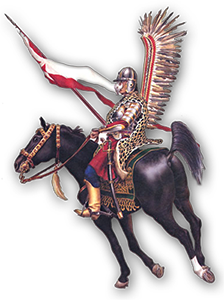 Polish Winged Hussar by Velimir Vuksic
Polish Winged Hussar by Velimir VuksicBrave, honorable, arrogant – deadly. The Winged Hussars were the elite Polish cavalry unit, fighting all over the battlefields of Baroque Europe, from 16th through the 18th centuries. The Hussars were direct descendants of medieval knights and were well versed in the art of war. Their tactics, weaponry, incredibly high morale, love of their fatherland and stunning appearance, all contributed to their spectacular successes in countless wars and battles.
The Winged Hussars’ legacy inspired friends and foes alike, influencing nations the world over. In the United States, the Polish count and Continental Army General, Casimir Pulaski (named the father of US cavalry), trained George Washington’s troops in methods that were derived from those of the Winged Hussars. In today’s Poland, the image of the Winged Hussar is still revered as a symbol of strength, honor, prestige and bravery.
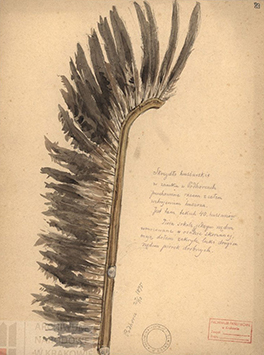 Courtesy: the Krakow National Archives
Courtesy: the Krakow National ArchivesThe most spectacular and mythical feature of the Hussars were their iconic wings. Many historians argued that they served purely a ceremonial purpose and were worn only during parades – not until recently was it conclusively proven that they were also in fact worn in battle. Throughout the existence of the Hussars, the wings went through many variations and evolved over time into their most recognizable shape.
The wings gave the riders the appearance of giant birds of prey – combined with predator skins the Hussars draped their armor with, they instilled a very primal fear into the hearts of the enemy and enemy horse alike. The Winged Hussars descended upon their foes like avenging angels, charging with the fury of wild animals, sowing panic and discord amongst enemy ranks by their appearance alone.
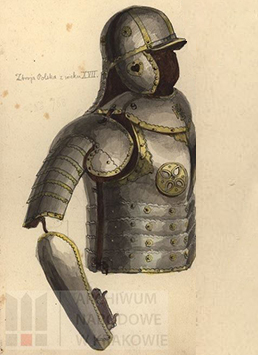 Courtesy: the Krakow National Archives
Courtesy: the Krakow National ArchivesThe Hussars were one of the most flexible and best armed military units of their time. Their primary offensive weapon were ~20 foot long lances, which were longer than their West European equivalents and much longer than the common infantry pike. Once a lance was shattered and the enemy formation broken, a Hussar was able to continue his assault with an assortment of weapons that were secured to his saddle: a long thrusting sword (koncerz), a backsword (palasz), a sabre (szabla), a warhammer (nadziak), two wheellock pistols and at times even a bow.
Hussar armor was light but incredibly effective – the breastplate was impervious to both musket and pistol fire and there are records of it being able to sometimes effectively stop cannon shot. Combined with steel szyszak helmets, gorgets, vambraces and chainmail, the Winged Hussars, galloping atop their powerful Arabian-bred horses (the most expensive part of a Hussar’s implements), were nearly unstoppable.
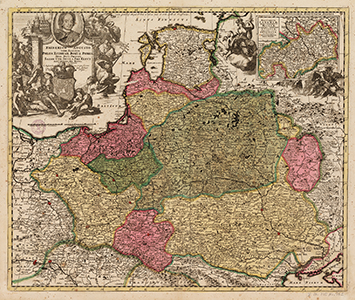 The Polish-Lithuanian Commonwealth
The Polish-Lithuanian CommonwealthThe Polish-Lithuanian Commonwealth of the 15-18th centuries, was the largest kingdom in all of Europe, spanning nearly 382,241 square miles (one and a half the size of Texas). Unprecedented for its time, it was a culturally and ethnically diverse land (50% of its population were immigrants), where every religion was tolerated (Christianity, Protestantism, Judaism, Orthodoxy, Islam, etc.) and where its king was elected in a democratic fashion.
The Commonwealth’s territory, stretching from the Baltic in the north all the way to the Black Sea in the south, consisted mostly of a vast plain – perfect terrain for invading armies. The kingdom existed in an almost perpetual state of war, fighting against Russians, Swedes, Ottomans, Austrians, Prussians, Cossacks, Tartars, Moldavians, Wallachians, Transylvanians, Danes, et.al. Due to the Commonwealth’s immense size, the Pole-Lithuanians relied mostly on cavalry to rapidly traverse its lands and face their enemies. The elite Winged Hussars soon became the backbone of their fatherland’s defense.
The Winged Hussars were one of the most successful cavalry units in history, despite perpetually facing a numerically superior enemy.
Here are some of their most spectacular successes on the battlefield:
1531 | Battle of Obertyn | 17,000 Moldavians vs. 5,651 Poles | 3:1 RATIO
1575 | Battle of Lubieszów | 12,000 Danzigers vs. 2,500 Poles | 5:1 RATIO
1601 | Battle of Wenden | 3,000 Swedes vs. 700 Poles | 4:1 RATIO
1605 | Battle of Kircholm | 21,736 Swedes vs. 7,200 Poles | 3:1 RATIO
1610 | Battle of Klushino | 35,000 Russians vs. 6,800 Poles | 5:1 RATIO
1621 | Battle of Khotyn | 197,820 Ottomans vs. 60,000 Poles | 3:1 RATIO
1673 | Battle of Lwów | 20,000 Ottomans vs. 6,000 Poles | 3:1 RATIO
1683 | Battle of Vienna | 300,000 Ottomans vs. 110,700 Poles | 3:1 RATIO
1694 | Battle of Hodów | 40,000 Tatars vs. 400 Poles | 100:1 RATIO
Note: “Poles” denotes Pole-Lithuanians and at times includes their Allies.
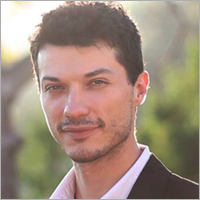 Polish-born, New York and Los Angeles based photographer, cinematographer and graphic artist. His family has a deep Polish cavalry connection, having had ancestors that led Hussar retainers in the 16th and 17th centuries under Czarniecki, led 18th century banners under Kosciuszko, all the way to the 20th century with his uhlan-cavalry grandfather that fought in World War 2. Luke’s family legacy combined with his lifelong passion for all things history, ignited a desire within Luke to share the story of the Winged Hussars with the world.
Polish-born, New York and Los Angeles based photographer, cinematographer and graphic artist. His family has a deep Polish cavalry connection, having had ancestors that led Hussar retainers in the 16th and 17th centuries under Czarniecki, led 18th century banners under Kosciuszko, all the way to the 20th century with his uhlan-cavalry grandfather that fought in World War 2. Luke’s family legacy combined with his lifelong passion for all things history, ignited a desire within Luke to share the story of the Winged Hussars with the world. Polish historian, journalist, reenactor and the foremost Winged Hussar expert. Dr. “Radek” was the first person in the world to write a doctoral dissertation fully devoted to the subject of the Hussars and has went on to write dozens of articles and books on their rich history, battles, tactics, armament and legacy.
Polish historian, journalist, reenactor and the foremost Winged Hussar expert. Dr. “Radek” was the first person in the world to write a doctoral dissertation fully devoted to the subject of the Hussars and has went on to write dozens of articles and books on their rich history, battles, tactics, armament and legacy.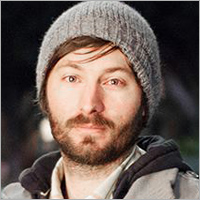 Art Director Andy has crafted identities and worked on marketing campaigns for some of the biggest Hollywood movies to be released in the past few years, in addition to being a part of development teams for some of the most widely watched docureality series on American television. Andrew is also an avid follower of historical warfare. He traveled to Poland in 2008, which sparked his interest in the cultural and historical heritage of the region.
Art Director Andy has crafted identities and worked on marketing campaigns for some of the biggest Hollywood movies to be released in the past few years, in addition to being a part of development teams for some of the most widely watched docureality series on American television. Andrew is also an avid follower of historical warfare. He traveled to Poland in 2008, which sparked his interest in the cultural and historical heritage of the region.